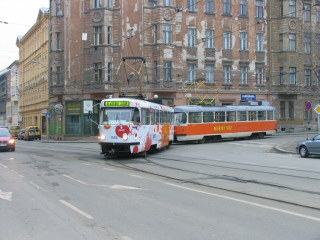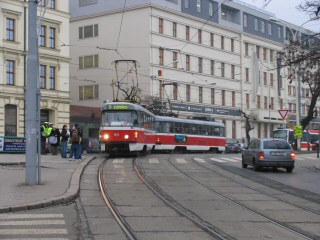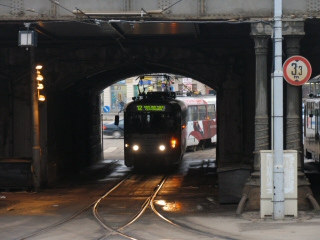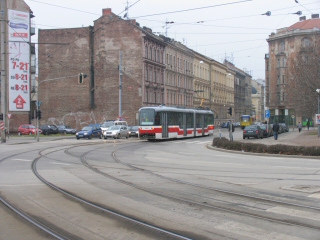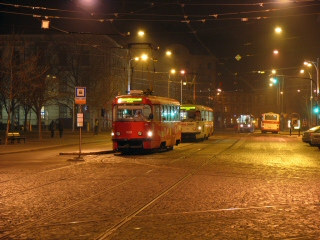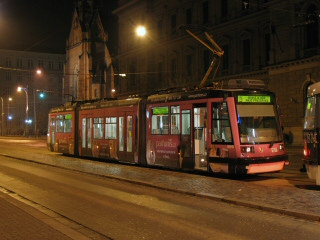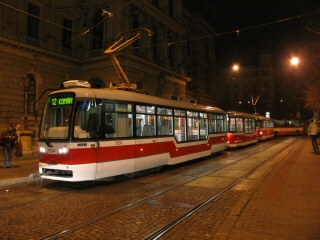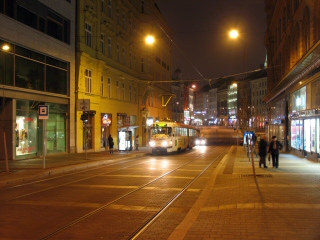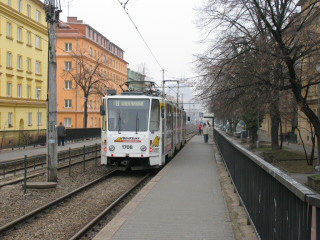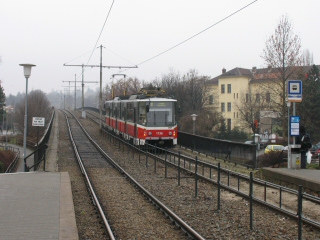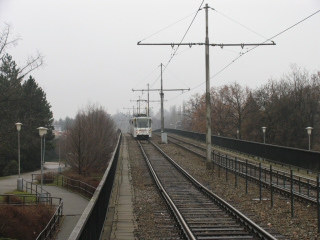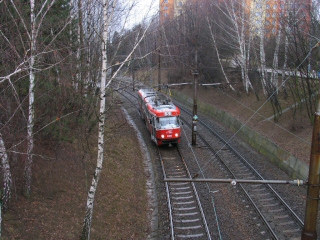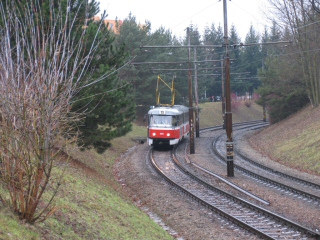budapest
other hungarian
close-up
lost rails
other countries
Although I'm not exactly a fan of Tatra trams, the variety of different types and modifications make Brno quite an interesting place for a "tramspotter". For example, the classic T3 is featured in ten different versions: T3IVCS, T3M, T3G, T3T, T3P, T3R, T3RF, T3R.EV, T3R.PV, and the low-floor "rebuild" VarioLFR.E, while the articulated K2 can be seen in seven makes: K2, K2R, K2R03, K2T, K2P, VarioLF2R.E and K3R-N. Of course some of these only differ from each other in their electric systems, but with the frequent usage of all-over advertisments, one could easily think there are no two trams alike in town. Also, because of the dense network and the integrated fare system it's the Zürich under "Eastern-European" (ex-Soviet-bloc) cities, always worth a visit!
On the picture to the left, we see two T3M cars -
unless I'm mistaken (the rear car does seem different). These feature
TV1 choppers which transform electric current into a screeching
noise motive power. On the right-hand side: a K2 pretty much in
its original state. I must admit, this articulated version of the
"round Czech PCC" is my favorite among the Tatras - its
measures (width versus length) look much more well-proportioned in
my eyes than those of the 4-axle T3.
Merging lines are characteristic for this city with a tram network of 70 kilometers of tracks/130 kilometers of route length. Such a network needs many intermediate termini/reversing loops, and Nové sady seen on the pictures above is one of these.
Hlavní nádraží - the main railway station - is the central node of the tram network. Here we see some trams at the underpassing near the station.
Until now we only saw classic types, but there are also some more modern trams in usage. The RT6N1 to the left was the swan-song of the Tatra works, and it was everything but a success. In fact these cars were rusting away in the depot, until one of the was put back into working order in 2008. On the right is the "ski boot", the newest type in Brno: the Škoda 13T.
A short video of the RT6N1. I would not say I liked this vehicle.
And now the 13T. I tend to call it a "rolling staircase", because it features low- and normal-floor parts divided by steps making passenger flow hard - but on the other hand, it rides much smoother than the RT6N1.
And remark: I liked the passenger information systems all over the vehicles in Brno! Visual information where possible, and automatic PA even on the oldest trams, plus the most important places (train station, theater) were also displayed in english and german.
The low-floor "re-make" of the K2 is called the VarioLF2R.E.
The line running through the upper parts of the inner city was closed, so tram 4 was reversing in the junction at Komenského náměstí. It seems tram drivers have had their pauses here before departing, so there were always many trams waiting in the stop at Česká, as we can see on the photo to the left. To the right: the 03T type is basically a modernised version of the "two-rooms-and-a-bath" principle - I thought its riding comfort was inferior to the bogie cars.
On the left we see an interesting set, consisting of a VarioLFR.E (the low-floor "re-make" of the T3), an unpowered low-floor trailer designated VV60LF, and a T3-something. To the right: a K2 leaving Náměstí Svobody.
Variations: a T3R.PV to the left, a K3R-N to the right. The latter is a K2 with a retrofitted low-floor middle section.
I thought this latter vehicle was awful. It was very noisy (even to my ears being used to the bumpy Ganz artics of Budapest), and at some points I feared it would spring off the tracks in bends. Of course it stayed on track, but I did not like the experience.
On the plateau over the city there is a chain of huge housing areas. These are connected to the inner city with tram lines: 2, 5 and 7 over a detour in the city streets, and 8 and 10 via this straight, LRT-like alignment, which I liked very much. These pictures were taken near the stop Vsetínská, with bulky KT8D5 articulated cars to make the "Stadtbahn"-flavour even stronger.
LRT the Czech way - I like it.
After the viaduct the "city" and the "LRT" lines join and continue in a railway cutting. Although these picture may seem as if they were taken in some far-off forest, this was in the middle of the housing area.
Back to the top Back to the main page



